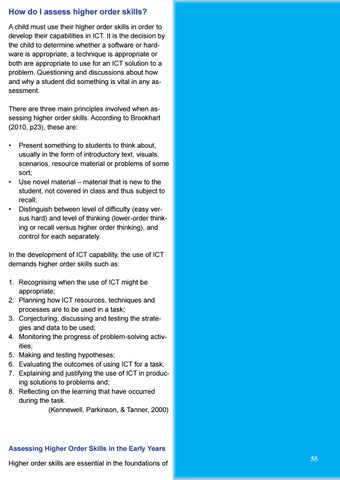How do I assess higher order skills? A child must use their higher order skills in order to develop their capabilities in ICT. It is the decision by the child to determine whether a software or hardware is appropriate, a technique is appropriate or both are appropriate to use for an ICT solution to a problem. Questioning and discussions about how and why a student did something is vital in any assessment. There are three main principles involved when assessing higher order skills. According to Brookhart (2010, p23), these are: • Present something to students to think about, usually in the form of introductory text, visuals, scenarios, resource material or problems of some sort; • Use novel material – material that is new to the student, not covered in class and thus subject to recall; • Distinguish between level of difficulty (easy versus hard) and level of thinking (lower-order thinking or recall versus higher order thinking), and control for each separately. In the development of ICT capability, the use of ICT demands higher order skills such as: 1. Recognising when the use of ICT might be appropriate; 2. Planning how ICT resources, techniques and processes are to be used in a task; 3. Conjecturing, discussing and testing the strategies and data to be used; 4. Monitoring the progress of problem-solving activities; 5. Making and testing hypotheses; 6. Evaluating the outcomes of using ICT for a task; 7. Explaining and justifying the use of ICT in producing solutions to problems and; 8. Reflecting on the learning that have occurred during the task. (Kennewell, Parkinson, & Tanner, 2000)
Assessing Higher Order Skills in the Early Years Higher order skills are essential in the foundations of
55











